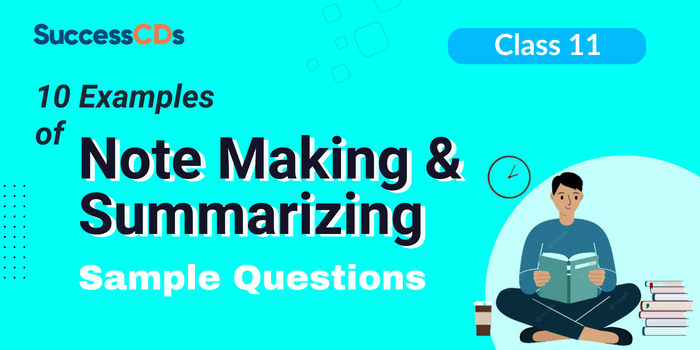
Are you looking for examples of Note Making and Summarizing for Class 11, no worries, you’ve come to the right place! Our post provides 10 Note Making and Summarizing samples based on previous years’ exam question papers. These examples of Note Making and Summarizing can help you understand the format, tone, and language used in such writing skills. We offer detailed explanations for each sample and highlight the important features that make it effective. You can use these examples of Poster Making as a reference to write your own letters or as a guide to improve your writing skills. So, check out our blog post and learn all about the examples of Note Making and Summarizing for Class 11!
Here we go….
Note Making and Summarizing 10 Examples based on previous years question papers
Example 1 – Read the following passage
Conversation is indeed the most easily teachable of all arts. All you need to do in order to become a good conversationalist is to find a subject that interests you and your listeners. There are, for example, numberless hobbies to talk about. But the important thing is that you must talk about other fellow’s hobbies rather than your own. Therein lies the secret of your popularity. Talk to your friends about the things that interest them, and you will get a reputation for good fellowship, charming wit, and a brilliant mind. There is nothing that pleases people so much as your interest in their interest.
It is just as important to know what subjects to avoid and what subjects to select for good conversation. If you don’t want to be set down as a wet blanket or a bore, be careful to avoid certain unpleasant subjects. Avoid talking about yourself, unless you are asked to do so. People are interested in their own problems, not in yours. Sickness or death bores everybody. The only one who willingly listens to such talk is the doctor, but he gets paid for it.
To be a good conversationalist you must know not only what to say, but how to say it. Be mentally quick and witty. But don’t hurt others with your wit. Finally try to avoid mannerism in your conversation. Don’t bite your lips or click your tongue, or roll your eyes or use your hands excessively as you speak.
Don’t be like that Frenchman who said, “How can I talk if you hold my hand?”
(a) One the basis of your reading of the above passage, make notes on it using headings and subheadings. Use recognizable abbreviations (minimum four) and a format you consider suitable. Supply a suitable title to it. (5)
(b) Make a summary of the above passage in about 80 words. (3)
Ans.
How to Be A Good Conversationalist
I. What to do?
1. Int. topics
1.1. Hobbies
1.2. Acc. to other person’s personlty.
2. Mentally quick and witty
3. Listen to problems
II. What not to do?
1. Topics to avoid
1.1. Urself.
a. Hobbies
b. Problems
c. Sickness
d. Death
1.2. Unpleasant topics
2. Don’t hurt others with ur wit
3. Mannrsms.
1.1. biting lips
1.2. clicking tongue
1.3. rolling eyes
1.4. use hands too much
1.5. Frenchman
III. Result
1. Popularity
2. Famous for good fellship. , charm, wit, and mind

SUMMARY:
How to Be A Good Conversalist
Being a good conversalist is the key to being popular. To be a good conversalist, one should know what topics can interest the person you are speaking to. Talking about their hobbies is a good start. Avoid talking about yourself, your hobbies and problems. Adding witty comments enhances your conversation. Make sure that your wit does not hurt the sentiments of the person. Avoid unnecessary mannerisms. Doing this will make you a good fellow to be with.
Example 2 – Read the following passage
You may never want to fly kites to keep away evil spirits, as the Chinese have done for centuries, or to make rain, as the Tibetans did, but some more modern and western uses may tempt you to try experimenting yourself along similar lines. Ancient and medieval Chinese sources describe kites being used for measuring distances, testing the wind, lifting men, signalling and communication for military operations.
The earliest known Chinese kites were flat (not bowed) and often rectangular. Later, tailless kites incorporated a stabilising bowline. Kites were decorated with mythological motifs and legendary figures; some were fitted with strings and whistles to make musical sounds while flying. From China, kites were introduced to Cambodia, India, Japan, Korea and the western world.
The most widespread use of kites in modern times has been for meteorological investigations. Everybody knows about how Benjamin Franklin, the great American scholar and statesman, sent a kite up in 1752 during a thunderstorm to prove that lightning was caused by electricity. He produced sparks at ground level from a key hung on the wet line as the current flowed down it.
A second investigator repeated Franklin’s experiment shortly afterwards and was killed. By sending up instruments on kites it has been possible to make readings of air pressure, temperature, speed, direction and humidity. Although thermometers had been sent up long before, it was not until 1894, that a self-reading thermometer, a thermograph, was sent up by a kite.
(a) One the basis of your reading of the above passage, make notes on it using headings and subheadings. Use recognizable abbreviations (minimum four) and a format you consider suitable. Supply a suitable title to it. (5)
(b) Make a summary of the above passage in about 80 words. (3)
Ans.
History of Kites
I. Origin
1. Chinese
1.1. flat
1.2. rectanglr.
1.3. used to keep away evil spirits
1.4. mythlgcl. and legendary figures
1.5. strings & whistles
2. Tibetan
1.1. to make rain
II. Modern Times
1. meteorlgcl. investigations
1.1. sending instruments on kites
1.2. taking readings of temp., speed, direction, humidity, ap.
2. Benjamin Franklin
2.1. American scholar & statesman
2.2. experiment done in 1752
a. sent kite up during thunderstorm
b. to prove – lightning caused by electcty.
c. produced sparks at ground level from key on wet line
2.3. Second investigator died
3. Military operations
III. Thermograph
1. 1894
2. self-reading thermometer
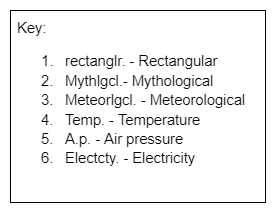
SUMMARY:
History of Kites
Kites are of Chinese and Tibetan-origin. The Chinese kites were flat and mostly rectangular, with mythological or legendary figures on them. While the Chinese used kites to ward off evil spirits, the Tibetans used kites to bring rain. Now, kites are used to measure air pressure, temperature, humidity, speed and direction of the wind. This use was discovered by Benjamin Franklin in 1752, who wanted to prove that lightning was caused by electricity. Taking readings has become easier with the invention of thermography.
Example 3 – Read the following passage
Homoeopathy has come to be known, over the years, as a form of medical treatment without side effects.
In the eighteenth century, Dr Samuel Hahnemann, convinced that existing medical practices did more harm than good, began to look for an alternative that would be safe, gentle, and effective. He reasoned that instead of suppressing symptoms as allopathy does, one should seek to stimulate and so encourage and assist the body’s natural healing process. Hahnemann had already discovered that a small dose of quinine in a healthy person produced the symptoms of malaria. A number of systematic experiments followed this discovery. Hahnemann then worked to establish the smallest effective dose as he realised that this was the best way to avoid side effects. In so doing, he unexpectedly discovered one of the basic tenets of homoeopathy, that the more a remedy was diluted, the more effective it became. Thus, by trial and perseverance, Hahnemann finally arrived at his goal.
One of the principles of homoeopathy is that a person’s response to a disease varies according to his or her basic temperament. Thus, a homoeopathy doctor will take into account the patient’s temperament and responses to certain conditions before prescribing any medicine because it is the patient who is being treated and not the disease. Patients with the same ailment may often require different remedies.
Homoeopathy does not reject the great discoveries of modern science, only their commercial abuse. In many cases, homoeopathy is complementary to the newer methods of modern medical practice.
(a) One the basis of your reading of the above passage, make notes on it using headings and subheadings. Use recognizable abbreviations (minimum four) and a format you consider suitable. Supply a suitable title to it. (5)
(b) Make a summary of the above passage in about 80 words. (3)
Ans.
Homoeopathy
I. What is it?
1. med. treatment w/o side effects
2. rejects commercial abuse of science
3. Complimntry. to new med. practice
4. basic principle – an ind. responds to a disease acc. to his tempramnt.
5. two people with same disease may need diff. treatment
II. Allopathy
1. contrary to hompathy.
2. suppresses symptoms
III. Dr Samuel Hahnemann
1. 18th century
2. Allopathy is harmful
3. Searched for alt.
3.1. encourage the natural healing process
3.2. systematic experiments
3.3. saw that smallest dose was effective
3.4. discovered a tenet – more remedy is diluted, more effective it is

SUMMARY:
Homoeopathy
Homoeopathy is a type of medical treatment without any side effects. Unlike allopathy which suppresses the symptoms, homoeopathy focuses on enhancing the natural healing process. The basic principle is that a person responds to a disease according to his or her temperament. Dr Samuel Hahnemann saw that modern practices were harmful. After doing systematic experiments, he discovered that the smallest dose of a medicine was effective enough to stop the disease. This showed that the more a remedy is diluted, the more effective it is – one of the tenets of homoeopathy.
Example 4 – Read the following passage
Despite the French sounding name, papier mache was not made in France until the mid – seventeenth century. However, they were the first country in Europe to do so. Papier mache actually originated from China; the inventors of paper itself. They used papier mache to make helmets of all things, which they toughened by many layers of lacquer. Examples have been found dating back to the Han Dynasty (BC 202 – AD 220).
From China, the interest in papier mache spread to Japan and Persia, where it was used in mask making and festival activities. Eventually it spread across the world. Large imports of papier mache objects swamped European markets. This in turn led France to start making its own wares, and England followed suit in the 1670s.
Papier mache (French for “chewed paper”) is believed to have got its name from French workers in London papier mache shops who did just that!
In 1740, the manufacturer John Baskerville, well known for his fine quality books and typefounding, began to imitate the lacquered pieces from Japan. This is how the term “japanning” came about. His business was very successful and later his assistant Henry Clay, invented a way to produce papier mache so strong that it was equally as durable as wood. He did this by glueing specially prepared paper under heat to form tough, heat resistant panels.
(a) One the basis of your reading of the above passage, make notes on it using headings and subheadings. Use recognizable abbreviations (minimum four) and a format you consider suitable. Supply a suitable title to it. (5)
(b) Make a summary of the above passage in about 80 words. (3)
Ans.
Papier Mache
I. Origin
1. China
1.1. inventors of paper
1.2. used to make helmets
2. Han Dynasty (BC 202 – AD 220)
3. Spread to Japan and Persia
3.1. used for mask making & festival actvties.
4. Spread to Europe
4.1. France – first country
4.2. England followed in 1670s
II. France
1. First country in Europe
2. Name “p.m.” is French
2.1. Meaning – “chewed paper”
2.2. got its name from French workers in London p.m. shops
III. John Baskerville
1. Manufacturer
1.1. famous for books and typefounding.
2. 1740
2.1. Began to copy the lacqed. pieces from Japan
2.2. Japaning
3. Henry Clay
3.1. Assistant
3.2. Made p.m. as durable & strong as wood
3.3. Glued p.m. under heat to make hard & resistnt. panels
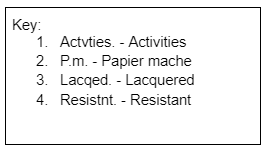
SUMMARY:
Papier Mache
Papier mache originated from China, the country which invented paper. It was used to make helmets. It spread to Japan and Persia, where it was used for mask-making and festival activities. France was the first European country to use it. It got its name from the French workers in London, which translates to “chewed paper”. John Baskerville was a famous businessman, who was greatly influenced by Japanese culture. His assistant, Henry Clay made papier mache as durable and strong as wood.
Example 5. Read the following passage: (Question Paper CBSE, 2020)
1. How does television affect our lives? It can be very helpful to people who carefully choose the shows that they watch. Television can increase our knowledge of the outside world; there are high quality programmes that help us understand many fields of study, science, medicine, the different arts and so on. Moreover, television benefits very old people, who can’t leave the house, as well as patients in hospitals. It also offers non-native speakers the advantage of daily informal language practice. They can increase their vocabulary and practise listening.
2. On the other hand, there are several serious disadvantages of television. Of course, it provides us with a pleasant way to relax and spend our free time, but in some countries people watch television for an average of six hours or more a day. Many children stare at the TV screen for more hours a day than they spend on anything else, including studying and sleeping. It’s clear that TV has a powerful influence on their lives and that its influence is often negative.
3. Recent studies show that after only thirty seconds of television viewing, a person’s brain ‘relaxes’ the same way that it does just before the person falls asleep. Another effect of television on the human brain is that it seems to cause poor concentration. Children who view a lot of television can often concentrate on a subject for only fifteen to twenty minutes. They can pay attention only for the amount of time between commercials.
4. Another disadvantage is that television often causes people to become dissatisfied with their own lives. Real life does not seem so exciting to these people. To many people, television becomes more real than reality and their own lives seem boring. Also many people get upset or depressed when they can’t solve problems in real life as quickly as television actors seem to.
5. Before a child is fourteen years old, he or she views eleven thousand murders on the TV. He or she begins to believe that there is nothing strange about fights, killings and other kinds of violence. Many studies show that people become more violent after viewing certain programmes. They may even do the things that they see in a violent show.
(a) One the basis of your reading of the above passage, make notes on it using headings and subheadings. Use recognizable abbreviations (minimum four) and a format you consider suitable. Supply a suitable title to it. (5)
(b) Make a summary of the above passage in about 80 words. (3)
Solution 1:
Suggested Notes as per CBSE
Advantages and Disadvantages of Watching Television
1. Benefits
1.1 increases know.
1.1.1 of outside world
1.1.2 science
1.1.3 medicine
1.1.4 diff. Arts
1.2 recreation for old ppl. & patients
1.3 informal lang. practice
1.4 increases vocab. & helps practise listening
2. Disadvantages
2.1 ppl. watch for 6 hrs. or more
2.2 students stare at screen for hrs.
2.3 negative influence
2.4 effect on human brain
2.4.1 poor conc.
3. Impact
3.1 feels life not very exciting
3.2 TV more real, life seems boring
3.3 depression when can’t solve problems
4. Violence shown on TV
4.1 children become violent
4.2 killings seem normal
Key to Abbreviations
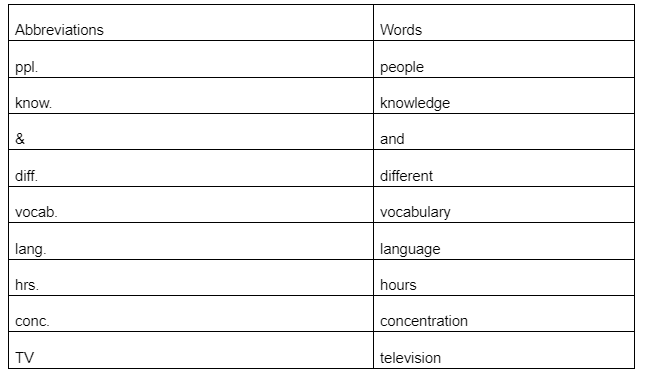
Summary
Advantages and Disadvantages of Watching Television
Watching television increases knowledge of the outside world, science, medicine and different arts. It helps old people and patients to recreate. It assists in informal language practice, improving vocabulary and practise listening. However, watching television for more than six hours and staring on screens has a negative influence on students. It affects the human brain and leads to poor concentration. Television makes life boring and nothing feels exciting. People can feel depressed when they are unable to solve problems as quickly as actors do. Television normalises violence which can make children violent.
Example 6. Read the passage given below: (Question Paper, CBSE 2019)
1. Well-being is not just the absence of disease or illness. It is a complex combination of a person’s physical, mental, emotional and social health factors. Well-being is strongly linked to happiness and life satisfaction. In short, it could be described as how one feels about oneself and one’s life. Every aspect of one’s life influences the state of one’s well-being. Researchers investigating happiness have found the following factors which enhance a person’s well-being : network of close friends, enjoyable and fulfilling career, enough money, regular exercise, nutritious diet, sufficient sleep, fun hobbies and leisure pursuits, healthy self-esteem, optimistic outlook and so on.
2. The factors that influence one’s well-being are interrelated. For example, a job provides not just money but purpose, goals, friendships and a sense of belonging. Some factors also make up for the lack of others; for example, a good marriage can compensate for a lack of friendship, while religious beliefs may help a person to accept physical illness. Money is linked to well-being, because having enough money improves living conditions and increases social status. But various international studies have shown that it is the quality of our personal relationships, not the size of our bank balance, which has the greatest effect on our state of well-being. Believing that money is the key to happiness can also harm a person’s well-being.
3. Understanding the well-being of the population is very important. Measuring well-being, however, in a population is difficult because the interpretation of well-being is so subjective — how one feels about peoples’ lives largely depends on the way one sees it. Like the saying goes: ‘one person’s problem is another person’s challenge.’
4. Keeping track of a population’s well-being helps governments to decide on particular policies. It also acts as an indicator for various population trends. For example, knowing the average weekly income of a population helps to set the ‘poverty line’, which may then influence decisions on social welfare reforms. Well-being can be achieved through a variety of means. Some are as follows : developing and maintaining strong relationships with family and friends, making regular time available for social contact, trying to find work that is enjoyable and rewarding, rather than just working for the best pay, eating healthy, nutritious foods, doing regular physical activity, involving oneself in activities that interest the people, joining in local organisations or clubs that appeal, setting achievable goals and working towards them and trying to be optimistic and enjoying each day.
(a) On the basis of your reading of the above passage, make notes on it using recognizable abbreviations (minimum four), wherever necessary. Use a format you consider suitable. Give it a suitable title also. (5)
(b) Write a summary of the above passage in about 80 words. (3)
Solution 2:
Suggested Notes by CBSE
Well Being
1. Definition of WB
1.1 absence of disease & illness
1.2 combination of physical, emotional & health factors
1.3 strongly linked to happiness & satisfaction
2. factors which improve WB
2.1 network of close friends
2.2 enjoyable, fulfilling career
2.3 enough money, good health
2.4 religious beliefs
3. Imp. of understanding people’s WB
3.1 helps govt. frame good policies
3.2 helps determine poverty line
3.3 helps take appropriate action
4. How best achieved
4.1 having strong relationship with family & friends.
4.2 enjoyable, rewarding work
4.3 involvement in interesting activities
4.4 nutritious food & good health
Key to Abbreviations

Summary
Well Being
Well- being not just refers to absence of disease and illness, rather it is a combination of physical, emotional and health factors. Well being is strongly linked to happiness and satisfaction. The factors that improve well being include a network of close friends, enjoyable and fulfilling career, money, good health and religious beliefs. It is important to understand people’s well being to frame government policies which would further help to determine the poverty line and take appropriate action. Well-being is best achieved by having strong relationships with family and friends, doing enjoyable and rewarding work, involvement in interesting activities and eating nutritious food for good health.
Example 7. Read the passage given below: (Question Paper CBSE, 2018)
Keeping cities clean is essential for keeping their residents healthy. Our health depends not just on personal hygiene and nutrition, but critically also on how clean we keep our cities and their surroundings. The spread of dengue and chikungunya are intimately linked to the deteriorating state of public health conditions in our cities.
The good news is that waste management to keep cities clean is now getting attention through the Swachh Bharat Mission. However, much of the attention begins and stops with the brooms and the dustbins, extending at most to the collection and transportation of the mixed waste to some distant or not so distant place, preferably out of sight.
The challenge of processing and treating the different streams of solid waste, and safe disposal of the residuals in scientific landfills, has received much less attention in municipal solid waste management than is expected from a health point of view.
One of the problems is that instead of focusing on waste management for health, we have got sidetracked into ‘‘waste for energy’’. If only we were to begin by not mixing the biodegradable component of solid waste (close to 60 percent of the total) in our cities with the dry waste, and instead use this stream of waste for composting and producing a gas called methane.
City compost from biodegradable waste provides an alternative to farmyard manure (like cow-dung). It provides an opportunity to simultaneously clean up our cities and help improve agricultural productivity and quality of the soil. Organic manure or compost plays a very important role as a supplement to chemical fertilisers in enriching the nutrient-deficient soils. City compost can be the new player in the field.
Benefits of compost on the farm are well-known. The water holding capacity of the soil which uses compost helps with drought-proofing, and the requirement of less water per crop is a welcome feature for a water-stressed future. By making the soil porous, use of compost also makes roots stronger and resistant to pests and decay. Farmers using compost, therefore, need less quantity of pesticides. There is also evidence to suggest that horticulture crops grown with compost have better flavour, size, colour and shelf-life.
City compost has the additional advantage of being weed-free unlike farmyard manure which brings with it the seeds of undigested grasses and requires a substantial additional labour cost for weeding as the crops grow. City compost is also rich in organic carbon, and our soils are short in this.
Farmers clearly recognize the value of city compost. If city waste was composted before making it available to the farmers for applying to the soil, cities would be cleaned up and the fields around them would be much more productive.
Quite apart from cleaning up the cities of biodegradable waste, this would be a major and sustainable contribution to improving the health of our soil without further damage by excessive chemical inputs. What a marvellous change from waste to health!
The good news is that some states are regularly laying plastic roads. Plastic roads will not only withstand future monsoon damage but will also solve a city’s problem of disposing of non-recyclable plastic. It is clear that if the mountains of waste from our cities were to be recycled into road construction material, it would tackle the problem of managing waste while freeing up scarce land.
(a) On the basis of your understanding of the above passage, make notes on it using headings and sub- headings. Use recognisable abbreviations wherever necessary (minimum four) and a format you consider suitable. Also supply an appropriate title to it. (5)
(b) Write a summary of the passage in about 80 words. (3)
Solution 3:
Suggested Notes as per CBSE
Waste Management: Some Facts
1. Reasons for keeping cities clean
1.1 to keep the residents healthy
1.2 health depends on
1.2.1 personal cleanliness
1.2.2 cleanliness of city
2. Reasons for waste management
2.1 being promoted through SBM
2.2 to sensitize imp. of waste separation
3. Challenges of waste management
3.1 has received less attn.
3.2 no focus on WM for health
3.3 biodegradable being mixed with solid waste
4. Benefits of organic manure
4.1 supplement of chem. fertilisers.
4.2 drought-proofing
4.3 makes roots stronger
5. Benefits of city compost
5.1 weed-free
5.2 more productive fields
5.3 chemical inputs avoided
6. Benefits of plastic roads
6.1 withstand monsoon damage
6.2 free lands from dumping waste
Key to Abbreviations
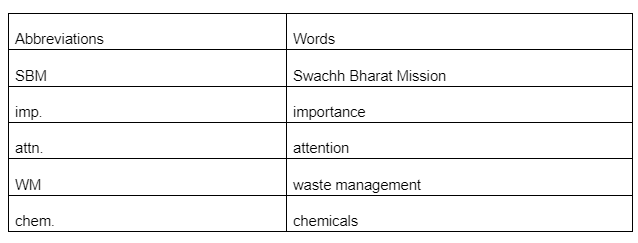
Summary
Waste Management: Some Facts
It is important to keep the cities clean to keep the residents healthy. Their health depends on personal cleanliness and the cleanliness of the city. It is crucial to sensitise the importance of waste separation. Waste management is promoted through Swachh Bharat Mission. Waste management is given less attention and biodegradable waste is mixed with solid waste. There is no focus on waste management for health. Organic manure acts as a supplement to chemical fertilisers, makes roots stronger and leads to drought-proofing. City compost is weed-free, avoids chemicals and leads to productive fields. Plastic rods are able to withstand monsoon and dumping is avoided.
Example 8. Read the passage given below: (Sample Question Paper CBSE, 2017-18)
1. Colour Therapy is a complementary therapy for which there is evidence dating back thousands of years to the ancient cultures of Egypt, China and India. If we define it in simple terms, Colour is a light of varying wavelengths, thus each colour has its own particular wavelength and energy.
2. Colours contribute to energy. This energy may be motivational and encouraging. Each of the seven colours of the spectrum are associated with energy. The energy relating to each of the seven spectrum colours of red, orange, yellow, green, blue, indigo and violet, resonates with the energy of each of the seven main chakras/energy centres of the body. Colour therapy can help to re-balance and/or stimulate these energies by applying the appropriate colour to the body.
3. Red relates to the base chakra, orange the sacral chakra, yellow the solar plexus chakra, green the heart chakra, blue the throat chakra, indigo the brow chakra (sometimes referred to as the third eye) and violet relates to the crown chakra.
4. Colour is absorbed by the eyes, skin, skull, our ‘magnetic energy field’ or aura and the energy of colour affects us on all levels, that is to say, physical, spiritual and emotional. Every cell in the body needs light energy – thus colour energy has widespread effects on the whole body. There are many different ways of giving colour, including; Solarised Water, Light boxes/lamps with colour filters, colour silks and hands on healing using colour.
5. Colour therapy can be shown to help on a physical level, which is perhaps easier to quantify, however there are deeper issues around the colours on the psychological and spiritual levels. Our wellbeing is not, of course, purely a physical issue. Fortunately, many more practitioners, both orthodox and complementary, are now treating patients in a holistic manner.
6. Colour Therapy is a totally holistic and non-invasive therapy and, really, colour should be a part of our everyday life, not just something we experience for an hour or two with a therapist. Colour is all around us everywhere. This wonderful planet does not contain all the beautiful colours of the rainbow for no reason. Nothing on this earth is here just by chance; everything in nature is here for a purpose. Colour is no exception. All we need to do is to heighten our awareness of the energy of colour, absorb it and see how it can transform our lives.
(a) On the basis of your understanding of the above passage, make notes on it using headings and sub- headings. Use recognizable abbreviations (wherever necessary-minimum four) and a format you consider suitable. Also supply an appropriate title to it. (5)
(b) Write a summary of the passage in about 80 words. (3)
Solution 4:
Suggested Notes as per CBSE
NOTE MAKING FORMAT FOR ABOVE QUESTION
Colour Therapy
1. Age old therapy
1.1 Found in
1.1.1 Egypt
1.1.2 China
1.1.3 India
1.2 light of vryng wvlngth & energy
2. Colour relate to energy of chakras
2.1 red –base
2.2 orange – sacral
2.3 yellow – solar plexus
2.4 green – heart
2.5 blue – throat
2.6 indigo – brow
2.7 violet – crown
3. Holistic benefits
3.1 phy’l
3.2 spirit’l
3.3 emtn’l
Key to Abbreviations
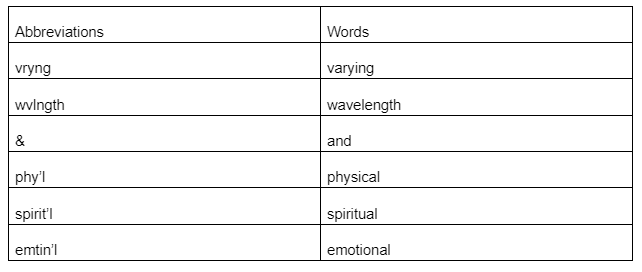
Summary
Colour Therapy
Colour therapy is an age-old therapy found in the cultures of Egypt, China and India. Each colour has light of varying wavelength and energy. Colours relate to the energy of chakras. Red is for base chakra, orange to sacral, yellow to solar plexus, green to heart, blue to throat, indigo to brow and violet to crown. Colour impacts us on all levels, including the physical, spiritual and emotional well being. Colour therapy has holistic benefits.
Example 9. Read the passage and answer the questions given below: (Sample Question Paper CBSE, 2018-19)
1. There is a clear dichotomy between Jayashankar Prasad’s daily life and the one that found expression in his literature. In his literary formulations, Prasad advocated an escape- from personality ideals and categorically stated: “An artist‟s art, and not his person, is the touchstone to assess his work . . . it is only after losing his personality that he emerges in his art as an artist”.
2. In Prasad‟s works – his poems, short stories, novels, dramas etc. – what emerges is life as shaped in the writer’s inner self by his emotions, fancies, dreams, reveries . . . His writings are a record not of outer reality, but of the artist’s inner world. As such, of a proper appreciation and understanding of his works more emphasis needs to be placed on the working of his mind, than the events of his dayto-day life.
3. Prasad was born in a renowned family of Varanasi. His grand-father Shiv RatanSahu, a dealer in high quality perfumed tobacco (snuff). Besides being an astute businessman, he was endowed with a marked cultural taste. His home was the meeting place of the local poets, singers, artists, scholars and men of religion. Prasad‟s father Devi Prasad Sahu carried forward this high tradition of family. Prasad, therefore, had a chance to study the various phases of human nature in the light of the business traditions, artistic taste and religious background of his family.
4. When the business had somewhat recovered, Prasad planned the publication of a literary journal. Prasad started the “Indu”. The inaugural number appeared in July 1909. By this time Prasad’s notions of literature had crystallized into a credo. In the first issue of Indu, he proclaimed, “Literature has no fixed aim; it is not a slave to rules; it is a free and all-embracing genius, gives birth to genuine literature which is subservient to none. Whatever in the world is true and beautiful is its subject matter. By dealing with the True and Beautiful it establishes the one and affects the full flowering of the others. Its force can be measured by the degree of pleasure it gives to the reader‟s mind as also by the criticism which is free of all prejudice”. The words sound like the manifesto of romanticism in literature.
5. Even while recognizing the social relevance of literature, Prasad insisted, “The poet is a creator . . . he is not conditioned by his milieu; rather it is he who moulds it and gives it a new shape; he conjures up a new world of beauty where the reader for the time being, becomes oblivious of the outer world and passes his time in an eternal spring garden where golden lotuses blossom and the air is thick and pollen”. Thus, the chief aim of literature according to Prasad is to give joy to the reader and to create a state of bliss in him. Later under the impact of Shiv Advaitism, this faith of Prasad got further strengthened.
(Extract from ‘Jayashankar Prasad- His mind and Art’ by Dr. Nagendra)
(a) On the basis of your understanding of the above passage, make notes on it using headings and subheadings. Use recognizable abbreviations (wherever necessary-minimum four) and a format you consider suitable. Also supply an appropriate title to it. (5)
(b) Write a summary of the passage in about 80 words. (3)
Solution 5:
Suggested Notes as per CBSE
Jayashankar Prasad- His life
1. His exprsn. in lit.
1.1 an escape
1.2 lose your personality
1.3 record of writer’s inner world
1.4 more emphsz. on mind than body
2. Personal life
2.1 renowned fam. of Varanasi
2.2 home- meeting place of the local poets, singers
2.3 grand-father- an astute businessman
2.4 had a chance to study phases of human nature
3. Started the “Indu”
3.1 in July 1909
3.2 proclaimed
a) lit. has no fixed aim
b) is free and all embracing genius
c) gives birth to genuine lit.
4. Social relevance of lit.
4.1 poet is a creator
4.2 moulds it
4.3 conjures up a new world of beauty
4.4 becomes oblivious of the outer world
5. Chief aim of lit.
5.1 give joy to the reader
5.2 create a state of bliss
Key to Abbreviations

Summary
Jayashankar Prasad- His life
Jayshankar Prasad found expression in literature and created an escape only after losing his personality. His writings are a record of the writer’s inner world with more emphasis on mind than body. He was from a renowned family of Varanasi where home-meetings of poets and singers would take place. His grandfather was an astute businessman and therefore Prasad had a chance to study phases of human nature. In July 1909, he started ‘Indu’, in which he proclaimed that literature has no fixed aim, is free and all embracing genius and gives birth to genuine literature. He recognised the social relevance of literature as the poet is the creator who mould it, conjures up a new world and becomes oblivious to the outer world. The chief aim of literature is to give joy to the reader and create a state of bliss.
Example 10. Read the passage given below: (Sample Question Paper CBSE, 2019-20)
BALANCING THE SCALES
Artificial intelligence (AI) is making a difference to how legal work is done, but it isn’t the threat it is made out to be. AI is making impressive progress and shaking up things all over the world today. The assumption that advancements in technology and artificial intelligence will render any profession defunct is just that, an assumption and a false one. The only purpose this assumption serves is creating mass panic and hostility towards embracing technology that is meant to make our lives easier.
Let us understand what this means explicitly for the legal world. The ambit of AI includes recognizing human speech and objects, making decisions based on data, and translating languages. Tasks that can be defined as ‘search-and-find’ type can be performed by AI.
Introducing AI to this profession will primarily be for the purpose of automating mundane, tedious tasks that require negligible human intelligence. The kind of artificial intelligence that is employed by industries in the current scene, when extended to the law will enable quicker services at a lower price. AI is meant to automate a number of tasks that take up precious working hours lawyers could be devoted to tasks that require discerning, empathy, and trust- qualities that cannot be replicated by even the most sophisticated form of AI. The legal profession is one of the oldest professions in the world. Thriving over 1000 years; trust, judgement, and diligence are the pillars of this profession. The most important pillar is the relationship of trust between a lawyer and clients, which can only be achieved through human connection and interaction.
While artificial intelligence can be useful in scanning and organizing documents pertaining to a case, it cannot perform higher-level tasks such as sharp decisionmaking, relationship-building with valuable clients and writing legal briefs, advising clients, and appearing in court. These are over and above the realm of computerization.
The smooth proceeding of a case is not possible without sound legal research. While presenting cases lawyers need to assimilate information in the form of legal research by referring to a number of relevant cases to find those that will favour their client’s motion. Lawyers are even required to thoroughly know the opposing stand and supporting legal arguments they can expect to prepare a watertight defence strategy. AI, software that operates on natural language enables electronic discovery of information relevant to a case, contract reviews, and automation generation of legal documents.
AI utilizes big-data analytics which enables visualization of case data. It also allows for creation of a map of the cases which were cited in previous cases and their resulting verdicts, as per the website Towards Data Science. The probability of a positive outcome of a case can be predicted by leveraging predictive analytics with machine learning. This is advantageous to firms as they can determine the return on investment in litigation and whether an agreement or arbitration should be considered.
(a) On the basis of your understanding of the above passage, make notes on it using headings and subheadings. Use recognizable abbreviations (wherever necessary- minimum four) and a format you consider suitable. Also supply an appropriate title to it. (5)
(b) Write a summary of the passage in about 80 words. (3)
SAMPLE NOTE MAKING FORMAT FOR ABOVE QUESTION
Solution 6:
Suggested Notes by CBSE
Artificial Intelligence: Not a threat
1. Not a threat
1.1 is of help
1.2 makes life easier
1.3 no profession defunct
2. AI.will help legal field
2.1 recog.human speech and object
2.2 making decisions based on data
2.3 translates langs.
2.4 do search and find tasks
3. AI. cannot perform high level tasks like
3.1 writing legal briefs
3.2 advising clients
3.3 apprng in courts
3.4 sharp decision making
4. Function of AI.
4.1 collates data
4.2 predicts probable outcomes
4.3 tells return on invest.
4.4 considering agreement or arbitration
Key to Abbreviations
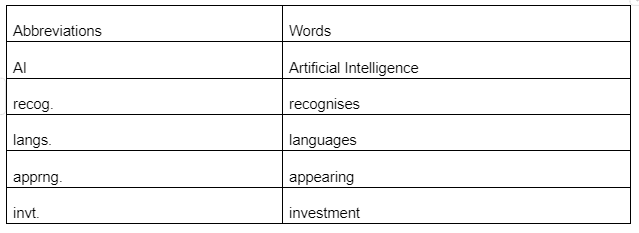
Suggested Summary as per CBSE
Summary
Artificial Intelligence: Not a threat
Artificial Intelligence is not a threat but makes life easier especially in the legal field. It cannot perform certain high-level tasks like writing legal briefs, advising clients, making sharp decisions and appearing in courts but it can collate data, aid research and decisions based on data. It can recognize human speech and translate languages. It can also predict probable outcomes, tell return on investment, consider agreement or arbitration and is thus advantageous to legal firms.